The Sabah Forestry Department, in collaboration with the BALI project (Biodiversity and Land-use Impacts on tropical ecosystem functioning) of the Human Modified Tropical Forests (HMTF) programme and South East Asia Rainforest Partnership (SEARRP) are organising a training day on ‘High Resolution Mapping of Sabah’s Forest Carbon’ to develop capacity in Carbon Stock Assessments. The workshop will be held at the Sabah Forestry Department, 29th June 2018 in Sandakan, and will focus on assessing carbon estimations with the Sabah REDD+ Technical Working Group with an emphasis on the importance of measuring, reporting and verifying carbon stocks in the State. This is an EU funded programme through the ‘Tackling Climate Change through Sustainable Forest management and Community Development’ initiative. For more information please visit the Bali website at http://bali.hmtf.info/news/training-on-high-resolution-mapping-of-sabahs-forest-carbon/.
Author: Katie King
HMTF Science Day, 27th June 2018, at the Institute for Tropical Biology and Conservation at the Universiti Malaysia Sabah.
The Human Modified Tropical Forests (HMTF) Programme is holding a science focused knowledge exchange today, June 27th 2018, at the Institute for Tropical Biology and Conservation at the Universiti Malaysia Sabah. The aim of this meeting is to share and discuss results from the BALI (http://bali.hmtf.info/), LOMBOK (http://lombok.hmtf.info/) and ECOFOR (http://ecofor.hmtf.info/) projects with local collaborators, researchers and students. The day will focus on science-based cross-consortia knowledge exchange and impact activities, scientific syntheses and reviews, and the potential for future grant proposals. After this meeting, many of the visiting scientists will have follow-up meetings that focus more specifically on policy and knowledge exchange with relevant stakeholders and policymakers in Sabah. For more information and the programme agenda for the HMTF Science Day, please visit http://hmtf.info/.
Workshop on the Benefits of Riparian Buffers in Sabah 26 June 2018, Le Meridien Kota Kinabalu, Sabah
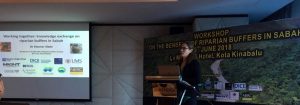
Dr Eleanor Slade introducing LOMBOK’s engagement with Sabah Government Stakeholders since 2016
Fifty representatives from government agencies, local and international universities, civil society organisations, and industry players will converge at this workshop to exchange knowledge and explore options for the effective design of riparian buffers in Sabah.
The workshop is officiated by Yang Berhormat Assaffal P. Alian, Assistant Minister for Tourism, Culture and Environment Sabah. Also present are the Ministry of Tourism, Culture and Environment Sabah Deputy Permanent Secretary Hajah Mariam Omar Matusin, Environment Protection Department Director Tuan Haji Mohd Yusrie Abdullah, Department of Irrigation and Drainage Sabah Deputy Director, Ir. Charles Yeo and SEARRP Director Datuk Dr. Glen Reynolds.
Dr Matthew Struebig of the University of Kent, one of the lead investigators in the LOMBOK Project stated that the research results are based on a five-year collaboration between scientists in UK universities, Universiti Malaysia Sabah, and the Forest Research Centre in Sepilok, to study rivers in oil palm plantations in the south east of Sabah. With funding from the UK’s Natural Environment Research Council (NERC), the British Council, and the Malaysian Industry-Government Group for High Technology (MIGHT) via Newton-Ungku Omar Fund, scientists have established a network of biodiversity monitoring and carbon dynamics plots within riparian buffers to test the effectiveness of riparian reserves. In particular, they have been investigating the effects of the quality and width of riparian buffers on water quality, aquatic and terrestrial biodiversity, and carbon fluxes.
Dr Agnes Agama, Assistant Director of SEARRP stated “We have been working to connect LOMBOK Project scientists with the DID and EPD. Both agencies have provided valuable input and advice that has helped the scientists to summarise their research and make it available in a form that is useful for planners and policy-makers in Sabah. Today’s workshop is a result of our collaboration with DID and EPD to share the research on the value of riparian buffers for biodiversity with the wider stakeholder community in Sabah.”
Permanent rivers in Sabah that are more than 3 metres wide require a vegetation zone of at least 20 m from each riverbank, as provided under the Sabah Water Resources Enactment (SWRE) 1998. This regulation is designed to protect water quality, water quantity, and aquatic environments. There are other regulations, such as Sabah Land Ordinance (Cap. 68), Sabah Environment Protection Enactment 2002 and Sabah Forest Enactment 1968, which allow for increasing riparian widths beyond the minimum 20m set by the SWRE 1998.
Strengthening the effectiveness of riparian reserves is crucial for improved landscape connectivity as well as the protection of important ecosystem services such as carbon sequestration, water quality and water quantity.
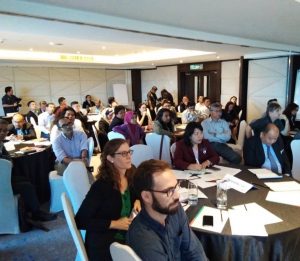
Participants at the Riparian Workshop
SEARRP, together with the Tropical Biology Association & Yayasan Hashanah, host Stakeholder Meetings to introduce a Toolkit for Ecosystem Services Site-based Assessment (TESSA)
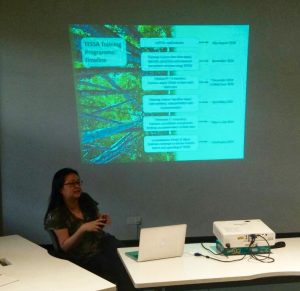
Dr Agama presenting the TESSA Programme timeline.
The SE Asia Rainforest Research Partnership (SEARRP), in collaboration with the Tropical Biology Association (TBA), is embarking on a project supported by Yayasan Hasanah to build capacity of conservation practitioners and natural resource managers to identify, prioritise and assess ecosystem services in Malaysia. This will be the initial phase (Phase One) of this project, which will be carried out over the next 18 months. Phase One commenced on May 1st 2018, and will pilot the Toolkit for Ecosystem Services Site-based Assessment (TESSA) in the Malaysian context.
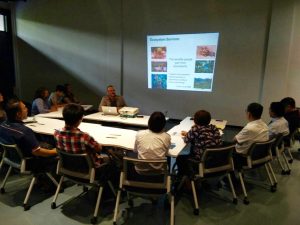
Dr Reynolds presenting the TESSA toolkit at recent stakeholders meeting
Collaboration between Human Modified Tropical Forests Programme (HMTF)-Land-use Options for Maintaining BiOdiversity and ecosystem (LOMBOK), SEARRP and Sabah Government Agencies
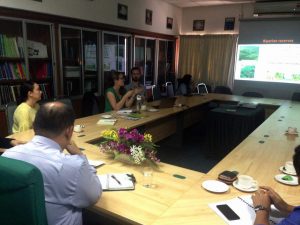
Dr Slade & Dr Bicknell in a recent meeting with relevant state government agencies.
Swansea University, UK Donates Engaging Environmental Education Exhibit to the Rainforest Discovery Centre in Sabah.
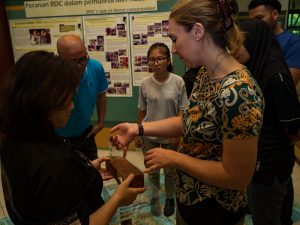
RDC Manager Bernadette Foeman & Prof Mary Gagen looking at the “Telling Time with Trees” exhibition.
“Telling Time with Trees,” which includes wood from Sabah, collected whilst Prof. Mary Gagen was sampling trees as a National Geographic Explorer, allows a hands-on and visual exploration of wood samples from around the world. The exhibit shows visitors how the rings in trees contain a historical record of the climate of the past, and how that record can help scientists understand climate change in the past and predict how the climate will change in the future. Before arriving at the Rainforest Discovery Centre, the “Telling Time with Trees” exhibit was on display in the UK and received more than 16,000 visitors.
Prof. Mary Gagen said “The Rainforest Discovery Centre is the perfect place for “Telling Time with Trees” to make a new home. The exhibit was created, using tree samples from all over the world collected for my research, for our Oriel Science centre in Wales. School children and members of the public learned all about tree ring science and got to examine and appreciate the beautiful Belian samples from Sabah. Oriel Science shares many of the same environmental science education goals of the RDC, and we’re delighted to share the exhibition, and these gorgeous wood samples, and we hope the visitors to the RDC enjoy the exhibit as much as we did in Wales”.
The exhibit donation was facilitated by the SEARRP. “We are delighted that local partners have responded so enthusiastically. We are keen to create more opportunities for Mary and her team at Swansea to collaborate with the network of environmental educators in Sabah on educational activities where local students use science to learn more about the rainforest,” said Dr. Glen Reynolds, Director of SEARRP.
Memorandum of Understanding between the South East Asia Rainforest Research Partnership (SEARRP) and Wild Asia Sdn Bhd
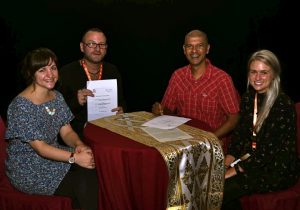 A five-year MoU between SEARRP and Wild Asia was signed on November 27th, 2017 and will commence on January 1st, 2018. This new partnership aims to draw on the strengths of both organisations in order to encourage scientific research with a focus on issues relating to small-holder production of palm oil and the livelihoods of rural and forest-dependent communities in Sabah.
A five-year MoU between SEARRP and Wild Asia was signed on November 27th, 2017 and will commence on January 1st, 2018. This new partnership aims to draw on the strengths of both organisations in order to encourage scientific research with a focus on issues relating to small-holder production of palm oil and the livelihoods of rural and forest-dependent communities in Sabah.
The collaboration will be based primarily at Wild Asia’s sites in Sabah and involve the communities with which they have built long-standing relationships – including at Beluran and on the Kinabantangan River. Working closely with these communities and Wild Asia, SEARRP aims to facilitate environmental and social research involving local and international scientists and teams of field staff from both Wild Asia and SEARRP.
This exciting new relationship for SEARRP will provide opportunities for scientists to work in under-studied landscapes and, we hope, for cutting edge research to better contribute to the livelihoods of local communities and the sustainability of smallholder agriculture. Through both organisation’s strong links with the Roundtable on Sustainable Palm Oil (RSPO), lessons learned from the SEARRP-Wild Asia partnership will potentially be scalable across SE Asia and the wider tropics through the RSPO’s smallholder certification programme, with which Wild Asia is closely involved, and SEARRP’s SEnSOR Programme (www.sensorproject.net).
A groundbreaking collaboration between the Sabah Department of Irrigation and Drainage, leading UK and Malaysian universities (University of Oxford, University of Kent, University of Lancaster, Universiti of Malaysia Sabah), and the South East Asia Rainforest Research Partnership (SEARRP).
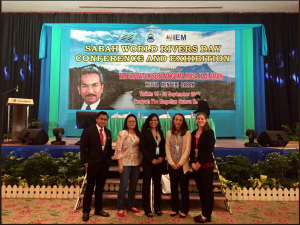
Representatives from DID, UK & Malaysian Universities and SEARRP
Scientists working together as part of the LOMBOK Project (Land-use Options for Maintaining BiOdiversity & eKosystem functions) aim to address this disparity by promoting the outcomes of their research to DID Sabah, which is the government agency responsible for formulating policy and guidelines on riparian reserves in Sabah. Additional funding from NERC, the British Council and the Malaysian Industry-Government Group for High Technology (MIGHT) via the Newton-Ungku Omar Fund, has enabled LOMBOK scientists to establish a network of biodiversity monitoring and carbon (C) dynamics plots within riparian reserves which tests the effectiveness of riparian reserves – particularly by investigating the effects of the quality and width of riparian reserves on water quality, aquatic and terrestrial biodiversity and carbon fluxes.
This innovative collaboration between DID and the LOMBOK Project was facilitated by Agnes Agama, SEARRP’s Assistant Director of Policy. Agnes initiated the partnership at the 2016 Heart of Borneo (HoB) International Conference, hosted by the Sabah Forestry Department in Kota Kinabalu – during which SEARRP facilitated a workshop that paired scientists with policy-makers. It was at this workshop that opportunities emerged for SEARRP scientists to support DID in their efforts to strengthen riparian policy and guidelines for Sabah.
Following the workshop, scientists in the LOMBOK group, Eleanor Slade, Sarah Luke, Matthew Struebig, and students from the UK and UMS conducted a rapid evidence appraisal of the peer-reviewed scientific literature concerning the potential benefits of riparian reserves in tropical agriculture. The outcomes of this review have been synthesised into a policy brief aimed at informing the review of DID’s riparian policy and guidelines by enabling policy-makers to make decisions based on current scientific knowledge. The policy brief will be co-presented by DID and the LOMBOK group at the 2017 HoB International Conference which runs from October 24-25th in Kota Kinabalu. The presentation will highlight the collaborative processes that underpin our relationship, from fledging introductions at last year’s conference to the delivery of a high-impact, science-for-policy output a year later. It is an excellent example of how scientists and policy-makers can successfully work together to ensure that cutting edge research effectively contributes to improvements in policy and best practice.
SEARRP scientists, led by Dr Mikey O’Brien, publish paper in Nature Ecology and Evolution
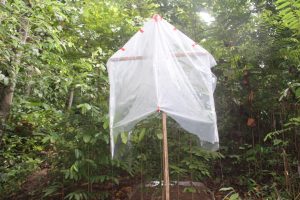
Connection between drought and climate change experiment 50HA plot SEARRP
The results of the study found that all seedlings responded to drought, but that seedlings in more diverse groups had less water stress than seedlings in monocultures after a severe drought. In addition, seedlings in the diverse groups maintained their growth similar to seedlings that never experienced drought. Therefore, complementary interactions among multiple species delayed the point at which water limited growth. Because seedling growth determines the future forest structure, these results demonstrate the importance of plant diversity for promoting drought resistance in tropical forests.
These findings have two major implications for our understanding of tropical forests under climate change. First, diversity promotes tree resistance to drought in tropical forests, which is important because drought is predicted to become more frequent and severe under climate-change scenarios. Second, because seedlings in monoculture neighborhoods were more inhibited by reduced water, drought has a role in driving diversity in tropical forests by reducing the success of seedlings in areas with low diversity. This indicates that a feedback exists whereby drought encourages diversity and diverse forests are more resistant to drought. However, this also means that biodiversity loss reduces the resistance of forests to drought which in turn can lead to further biodiversity loss. To prevent this reverse feedback loop, it is essential to conserve biodiversity in tropical forests — both by maintaining existing diverse forests and by using diverse seed mixtures when planting new forests during restoration. Using such diversity strategies will improve forest resistance to climate change.
Read the full paper here: Resistance of tropical seedlings to drought is mediated by neighbourhood diversity
New fees and booking guidelines for staying at the SAFE camp and Maliau Basin start August 1st 2017.
SAFE’s charges were set seven years ago but due to price increases across Malaysia, they are no longer able to offer these low rates. The new rates will start on the 1st of August 2017, and can be found here. The SAFE staff will begin taking this payment for room & board in cash, upon arrival at the SAFE camp. As before, all bookings should be made using the SAFE website.
Bookings for Maliau have also changed and now must be made two weeks in prior to going and payment to be made in advance. See here for more details. Please note that booking through the SAFE website will help with this process.
If you have any further questions regarding this new payment system please contact a member of the SEARRP team Adrian (adrian@searrp.org) or Katie (katie@searrp.org).
